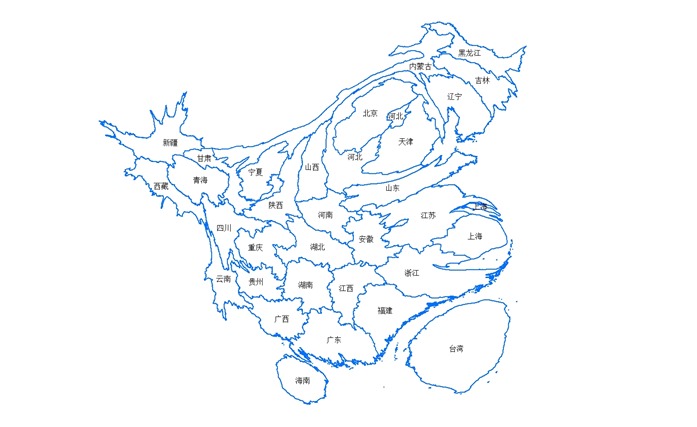"The areal units (zonal objects) used in many geographical studies are arbitrary, modifiable, and subject to the whims and fancies of whoever is doing, or did, the aggregating."
---------------------- Stan Openshaw (1983)
"Results about the effects of area-based attributes on individual behaviors or outcome can be affected by how contextual units or neighborhoods are geographically delineated and the extent to which these areal units deviate from the true geographic context."
---------------------- Mei-Po Kwan (2012)
GDP per capita in China in 2010 made by Worldmapper
I think the two references above have given very well-summarized accounts about the Modifiable Area Unit Problem (MAUP) and Uncertain Geographic Context Problem (UGCoP). They both state the essence of the problems, i.e., the causes where the problems arise. Interesting and simply put as they are, however, it is not easy to paraphrase them in a unsophisticated and easy-to-understand way. As such, this article aims to explain the two problems using words that don’t duplicate in the original articles by the authors.
Let’s look at the UGCoP first.
The essence of UGCoP is that the authenticity of research could be compromised due to the inaccurate description of the true geographic context by using geographic area/space. Put it in another way, it is the gap between the true geographic context and the geographical area/space we used to depict the context that has caused the problem. True geographic context here refers to the precise spatial configuration or areas that exert contextual influences on the individuals being studied. In the original article by Prof. Kwan, UGCoP is said to consist of two dimensions, which are spatial uncertainty and temporal uncertainty. Spatial uncertainty, from her point of view, is evidenced by several aspects in terms of the complexity of geographical context: multiple contexts of human activities, discrete geographical space which one context may cover, indefinable contexts by using geographical space (aspatial contexts), inaccurate geographical representation to the true geographical context, and lastly the variability of the contexts per se.
As for temporal uncertainty, however, it is not appropriate to mention the two uncertainties in the same breath, in my opinion. Spatial uncertainty is the major cause and component of UGCoP, while temporal uncertainty only plays a minor and subsidiary role component in UGCoP. Its function is only to make the problem of UGCoP more complicated. Specifically, the extensive temporal variability of human activities and contexts we study, as well as the time lag effect of contextual influence and human migration, add more complexities into spatial uncertainty.
MAUP is related to UGCoP, but it tells a different story. Let me explain by explicating their commonalities and differences.
Bothe MAUP and UGCoP share some common features. First, they both deal with the research result accuracy problem; Second they are both caused by ambiguous and untrue geographical delineation.
As for the differences, firstly, if you look into the nuance of the causes of the two problems, you will find the causes are actually different. MAUP is caused by arbitrary and unjustified zoning schemes, while UGCoP is due to the incomplete information transfer and inability of inter-describing between geographical space and contextual influences. Secondly, MAUP is almost incurable, while UGCoP can be remedied to some extent.
References
Openshaw, S. (1983). The modifiable areal unit problem (Vol. 38): Geo Books Norwich.
Kwan, M.-P. (2012). The uncertain geographic context problem. Annals of the Association of American Geographers, 102(5), 958-968.




 本文探讨了地理研究中两种常见的问题:可修改区域单位问题(MAUP)和不确定地理背景问题(UGCoP)。这两种问题均源于地理划分的模糊性和不准确性,影响研究结果的有效性。MAUP由任意且未经验证的区域划分引起;而UGCoP则涉及地理空间与情境影响间信息传递的不完整性。
本文探讨了地理研究中两种常见的问题:可修改区域单位问题(MAUP)和不确定地理背景问题(UGCoP)。这两种问题均源于地理划分的模糊性和不准确性,影响研究结果的有效性。MAUP由任意且未经验证的区域划分引起;而UGCoP则涉及地理空间与情境影响间信息传递的不完整性。

















 7069
7069

 被折叠的 条评论
为什么被折叠?
被折叠的 条评论
为什么被折叠?








